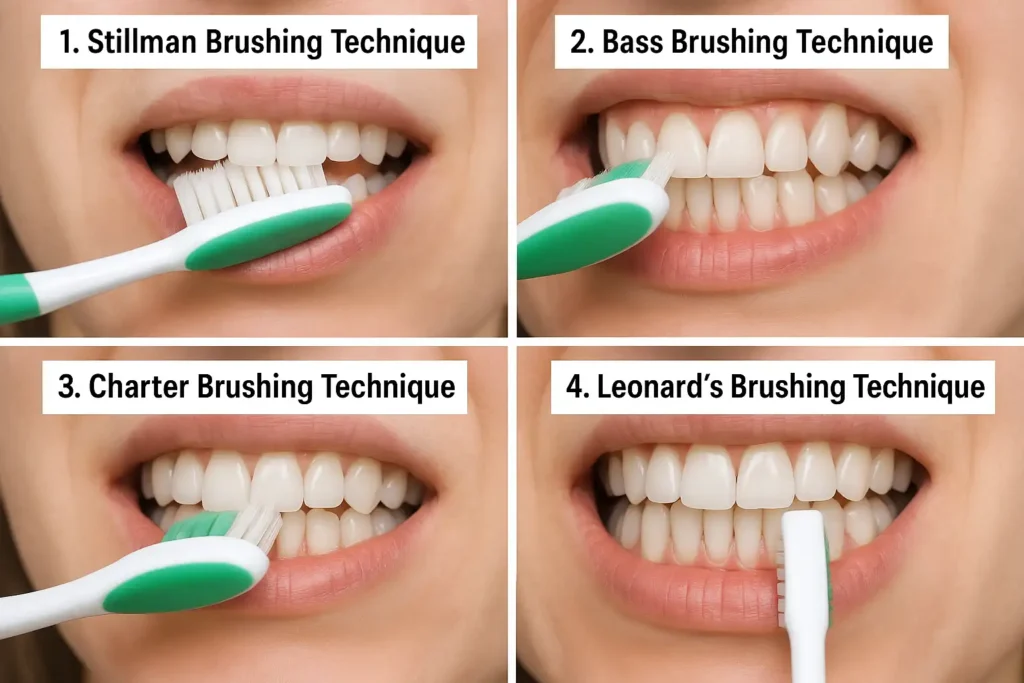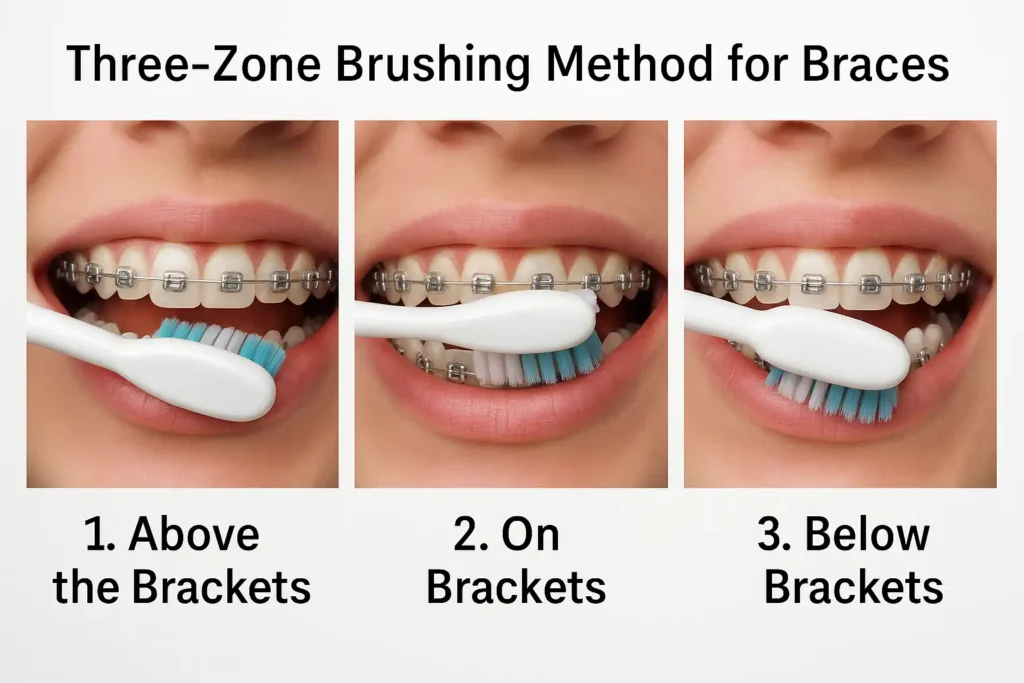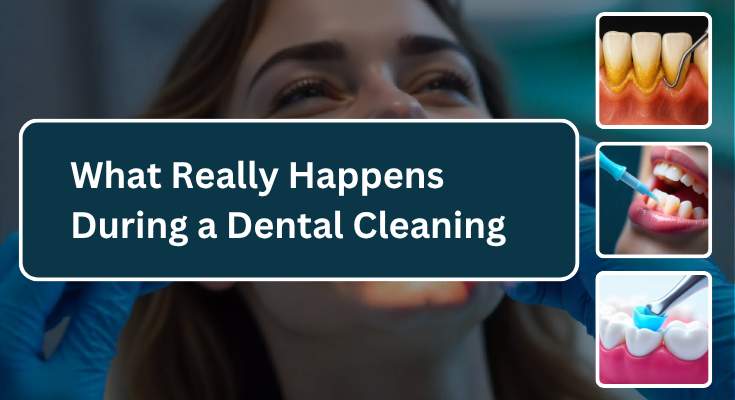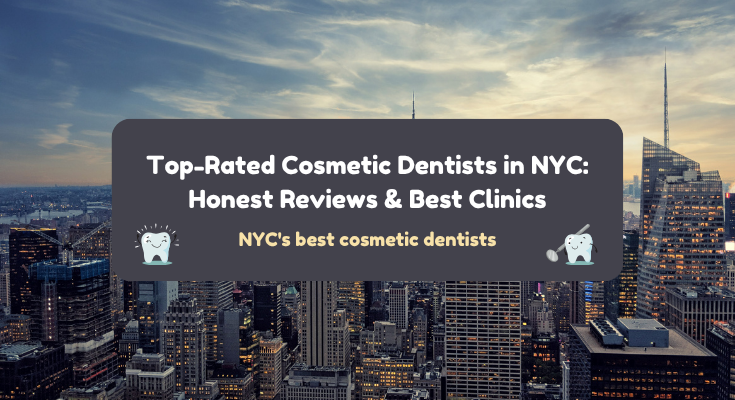8 Steps to Perfect Your Brushing Technique Tonight
Did you know your dental health could already be declining because of your brushing technique? That’s right, how you brush your teeth can be damaging your teeth and gums.
Taking care of your teeth starts with brushing correctly. Because dental health affects overall health, improving dental health should be a top priority. Exploring brushing techniques and finding the best one is a cost-free way to do this!
This blog helps you explore various brushing techniques and arrive at the best one for your needs.
Eight Steps to Perfect Your Brushing Technique for Efficient Cleaning
1. Toothbrush Choice
Would you believe that finding the correct method of brushing teeth starts with your toothbrush choice! Using the wrong toothbrush can lead to white spots on teeth, cavities, and other issues.
Dentists across America recommend a soft-bristle toothbrush. These softer bristles can bend, therefore accessing areas beneath the gumline.
This area is particularly vulnerable to food particle collection. If left uncleaned, these sites can lead to a buildup of particles and microorganisms, leading to dental plaque. In severe cases, dental plaque becomes tartar.
2. Brushing Intensity
One of the most common brushing mistakes is brushing too hard! It’s a mistake everyone makes, as brushing softer doesn’t make sense to everyone.
Brushing harder can actually cause more damage than cleaning. This is especially true if you pair rough brushing with a hard-bristle toothbrush.
In the initial buildup, the plaque is soft and less firm. This means you don’t have to brush as hard to remove it.
3. Amount and Type of Toothpaste
Most brushing techniques aren’t effective if they lack the appropriate toothpaste. The right toothpaste should contain the prescribed amount of fluoride and other minerals.
These substances play a crucial role in remineralization. It’s a natural tooth repair process where calcium and phosphate deposit onto the enamel. Enamel coats the outermost and hardest layer of teeth.
A pea-sized amount of toothpaste will be enough to brush your teeth. Remember, adding more won’t improve the quality of your brush.
Fluoride treatments help when you fail to get enough fluoride from toothpaste, diet, and water.
4. Direction of Brushing
Brushing in a fixed horizontal (left to right) or vertical (up and down) is far from the correct method of brushing teeth. The ideal brushing direction should be more of a multi-directional massage.
Starting from the base of the teeth or the gums. Gradually work up and down the teeth, but in a circular motion. This is the best way to clean teeth without doing any damage.
5. Accompany Brushing With Flossing
In addition to brushing, flossing at least once a day is necessary. This helps to dislodge any stubborn food particles that brushing may have left. This activity is useful if you know you have gaps between teeth.
Dentists recommend using good-quality floss to avoid potential damage from poor floss.
6. Brush for Long Enough
Dentists recommend that the duration of a healthy brushing is 2 minutes! Anything less may leave you vulnerable, and anything more can be damaging.
There are modern ways to ensure you’re brushing for an adequate time. You can set an alarm or timer on your phone. Alternatively, play a song out loud. By the end of the 2 to 3-minute song, you should be done.
7. Brushing Regularity
How often should teeth be brushed? We won’t blame you if you’re unsure because this is among the top 50 Questions Answered by Dentists.
The answer is twice a day for 2 minutes each time. Departing from this intended schedule can cause problems. Bad breath, plaque buildup, and gum disease are long-term effects of ignoring good brushing practices.
8. Don’t Forget Your Tongue
Cleaning your tongue should be a part of every brushing technique. Some toothbrushes come with a textured panel on the back of the toothbrush head for the tongue. If your toothbrush doesn’t have it, you can even use the soft-bristle head to clean your tongue.
Cleaning your tongue is an ideal way to end your morning brushing routine.
Brushing Techniques Types
More than one brushing technique exists to suit tooth and gum requirements.

1. Stillman Brushing Technique
This is one of the most used brushing techniques. It places the toothbrush at a 45-degree angle, allowing the cleaning of teeth and gums. Short, quick movements back and forth will help to clean the teeth while stimulating the gums.
A disadvantage of the Stillman Brushing Technique is gum tissue damage if too much pressure is applied. Additionally, using a toothbrush with hard bristles can lead to more damage to the enamel.
2. Bass Brushing Technique
This technique bears some similarity to the stillman technique. The toothbrush is angled at 45 degrees and in the direction of the gums.
The difference comes in the type of movement. Unlike the back-and-forth movements, this technique uses a gentle circular motion. This difference is useful for cleaning the entire gumline and the teeth.
The bass brushing techniques are the most recommended by dentists as they are effective. However, they are only effective when used properly. This makes it vital to listen to the dentist’s brushing advice.
3. Charter Brushing Technique
This is a technique that dentists suggest for people with issues such as gaps between teeth, orthodontic appliances, and gum recession.
Like the other brushing techniques, this one involves holding the toothbrush at a 45-degree angle. The movement is a back-and-forth and circular motion to eliminate any plaque and food particles.
4. Leonard’s Brushing Technique
This technique is mostly prescribed to children, especially those who still have their baby teeth. It’s an easy-to-master method that children will learn almost immediately.
In this method, the toothbrush is held at a 90-degree angle. Cleaning takes place through gentle vertical motions. Unfortunately, it’s not as effective for adults because it doesn’t clean below the gum line.
This straightforward technique is simple enough for children and is commonly known as the “vertical brushing method.”
Brushing Technique for Children
The simplest brushing techniques are used for children. The “vertical brushing technique” or Leonard’s brushing technique is most appropriate for children.
“While early brushing techniques for children don’t have to be complicated, a basic one is necessary. Parents shouldn’t ignore this, as early care is a huge dental payoff.” – Dr. Alexander Heifitz, founder of 65 Broadway Dental NYC.
It is simple and not complex like the other techniques. It’s also not as effective for severe plaque. But that’s okay for children, as they don’t have plaque buildup just yet.
This brushing process doesn’t involve any circular or back-and-forth motions. There are just gentle vertical movements to ensure cleaning of the temporary teeth.
Brushing Technique for Adults
The same brushing techniques that work for children are ineffective for adults. Brushing in a straight line and without an angle works for children. For adults, only angled toothbrushes and circular motions can remove plaque.
If you are trying to narrow down the brushing technique to the best one, it doesn’t exist. Everyone needs a brushing technique that suits their teeth, gums, and health. However, the guidelines for the perfect brushing technique are:
- Brush twice daily for a minimum of 2 minutes.
- Pay cheerful attention to gaps between teeth and cross the gum line.
- Removing food particles and plaque before they form tartar.
- Using reasonable force to avoid gum and tooth damage.
- Use the appropriate toothbrush, toothpaste, and floss.
Which Brushing Technique is Best For You?
As mentioned, identifying the best brushing technique depends on your specific requirement. Based on some specifications, ideal brushing techniques are as follows:
- People with orthodontic appliances: Charter Technique
- People with gum recession or damage: Modified Stillman or Charter Method
- People with lots of space between their teeth: Charter Technique
- People with healthy gums: Bass or Stillman Technique
- Children with their temporary teeth: Leonard’s Technique
Apart from using these brushing techniques, dentists stress the importance of flossing afterward.
Brushing Technique for Braces
There’s a different dental care process for people wearing braces. This is important to ensure teeth are cleaned, but without disturbing the braces.
Dentists agree that electronic toothbrushes do offer better cleaning than manual ones. However, even then, additional tools are necessary.
Interdental cleaning tools are smaller brushes that fit under the brace brackets and between them.
Ideally, people with braces can use the “Three-Zone Brushing Technique.”
Three-Zone Brushing Method
This brushing technique for people with metal/ceramic braces divides brushing into three stages based on area.

- Above the Brackets
This part requires the toothbrush to be at a 45-degree angle to clean the area above the brackets. A maximum of 30 seconds should be enough to clean this area.
- On the Brackets
Use circular rotational movements directed onto the brackets to clean the surface of the brackets. This won’t just clean the brackets but also the tooth surface immediately surrounding them.
- Below the Brackets
Angle your toothbrush at a 45-degree angle for better cleaning coverage below the brackets. Again, a 30-second brush in this area is enough.
What is Dry Brushing?
The dry brushing technique doesn’t involve toothpaste or a wet toothbrush head! In it, you’ll use a dry toothbrush to brush over teeth.
Although this technique is unfamiliar, it offers more benefits than toothpaste-based brushing. It’s even suggested that brushing can occur for longer when not using any toothpaste.
The dry brushing technique allows you to target those tooth surfaces that are not smooth. The lack of smoothness indicates plaque buildup.
Benefits of Dry Brushing
Dry brushing may not be the most popular brushing method, but it does offer these benefits.
Effective Plaque Removal
Because there is no toothpaste involved, you can clearly feel where the plaque is. This prompts you to pay special attention to these areas. You’ll know where to brush extra carefully to remove any remaining plaque or food particles.
Greater Convenience
If you don’t need toothpaste, you won’t need water or a sink. That’s another benefit the dry brushing technique provides. This technique is more accessible to people who are always on the move or busy.
Helps Strengthen Gums
Stimulating the gums improves blood flow, which can help with protection and healing. This is especially recommended for anyone with gum recession. It’s less harsh on the gums and can be used to help people with sensitive gums.
Allows for Longer Brushing
People who like to brush a bit longer can turn to dry brushing for extra cleaning time. This allows them to spend more time on areas that need additional care. This means people can easily exceed the 2 to 3-minute limit.
When is the Dry Brushing Technique Recommended?
The dry brushing technique is often recommended for many reasons.
- As a preliminary practice before regular brushing to improve brushing habits.
- For improving gum health.
- To quickly clean teeth while on the go.
- For people who are sensitive to toothpaste or regular brushing techniques.
- To help with fluoride absorption.
Despite all the direct types of brushing techniques, professional dental cleaning is still necessary.
If you’ve never had one, it’s never too late to make your first appointment. To know what to expect, here’s a brief of what happens during a dental cleaning.
Conclusion
Brushing your teeth isn’t just an activity. It’s a crucial part of starting your day and protecting your teeth. The earlier you start following the ideal brushing technique, the better your teeth will be.
Looking through all the brushing techniques to find your one is necessary. It helps you adopt a habit that benefits your teeth. At 65 Broadway Dental, we guide patients to the best brushing technique to prolong the longevity of teeth. In addition to this, we offer preventive & diagnostic, and cosmetic care.
FAQs
1. What is the importance of finding the right brushing technique?
Finding and using the right brushing technique is crucial for maintaining your dental health. Failing to use the correct method of brushing teeth can be harmful. Incorrect brushing can damage teeth and potentially irritate gum tissue.
2. What are the signs of brushing too hard?
There are several signs of brushing too hard. The signs include sensitivity, gum recession, lengthened appearance, and bleeding gums. Another sign is a frayed toothbrush!
3. What happens if I use too much fluoride toothpaste?
Overusing fluoride toothpaste can have some ill effects. Dental fluorosis, or over ingestion of fluoride, causes white spots, pitted teeth, or discoloration.
4. What is the most effective brushing technique?
The most effective brushing technique is widely accepted as the Bass technique for normal teeth. However, people with dental ailments or spaces between teeth would prefer the Charter technique.
5. Is tongue scraping really necessary?
Yes, cleaning your mouth isn’t complete without cleaning the tongue. A soft toothbrush or a textured back is suitable for cleaning the tongue.

Dr. Alexander Heifitz (Author)
Dr. Alexander Heifitz is the founder of 65 Broadway Dental in NYC, where he combines advanced dental expertise with a patient-first approach. He specializes in cosmetic and restorative treatments such as dental implants, veneers, Invisalign, and smile makeovers, helping New Yorkers achieve both oral health and confidence.
Booking An Appointment
Looking for a reliable dentist in Downtown NYC? Whether you need a routine cleaning, urgent care, or a full smile transformation — we’ve got you covered. We accept most PPO insurance plans and offer flexible scheduling.
+1 (212) 430-3888
Call for appointment
Walk-ins Welcome / Same-Day Appointments Available

Related Blogs

What Happens During a Dental Cleaning?
Learn what to expect during a dental cleaning, from plaque removal to polishing, so you can walk in with confidence and leave with a brighter, healthier smile.
Read More
Top NYC Cosmetic Dentists Reviewed for Quality & Care
Explore NYC's top-rated cosmetic dentists with real patient reviews. Find the best clinics for veneers, whitening, smile makeovers, and expert dental care.
Read More